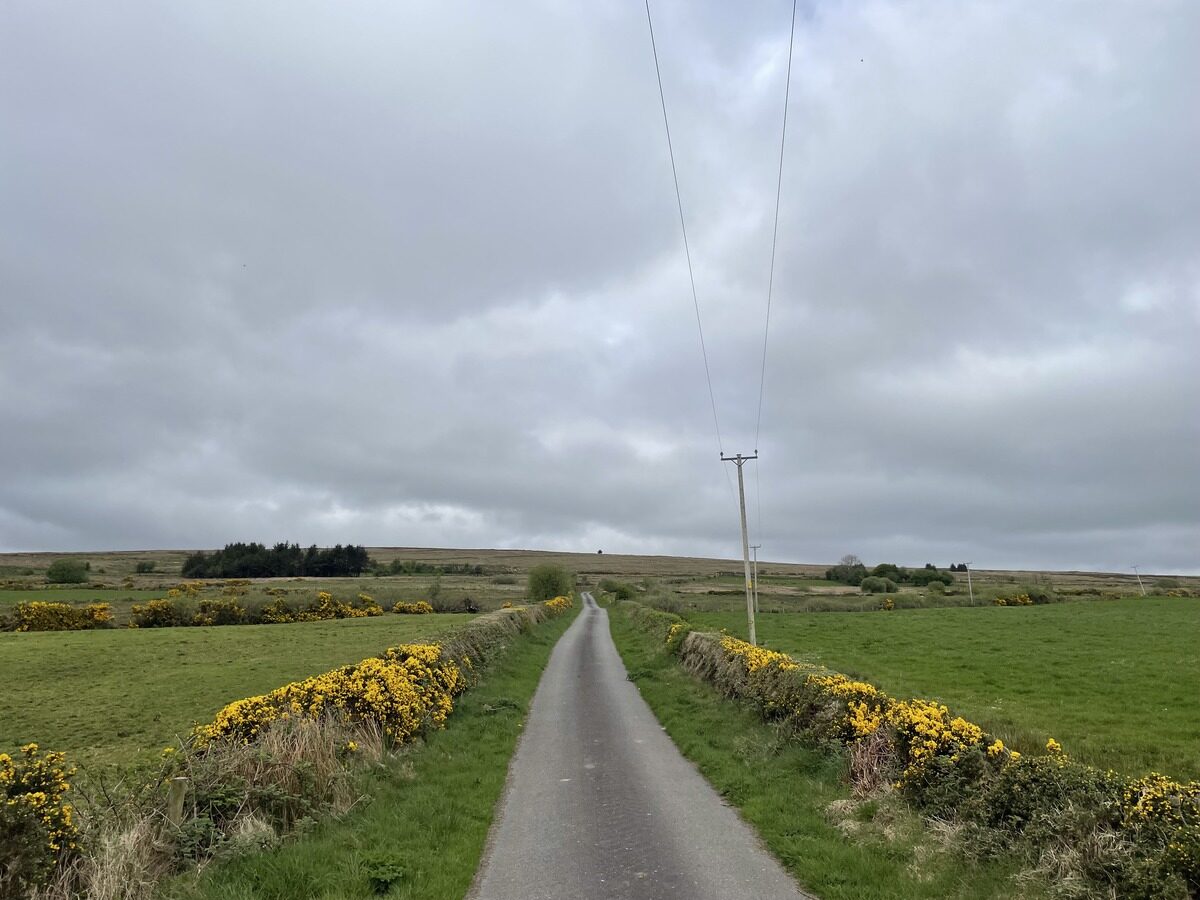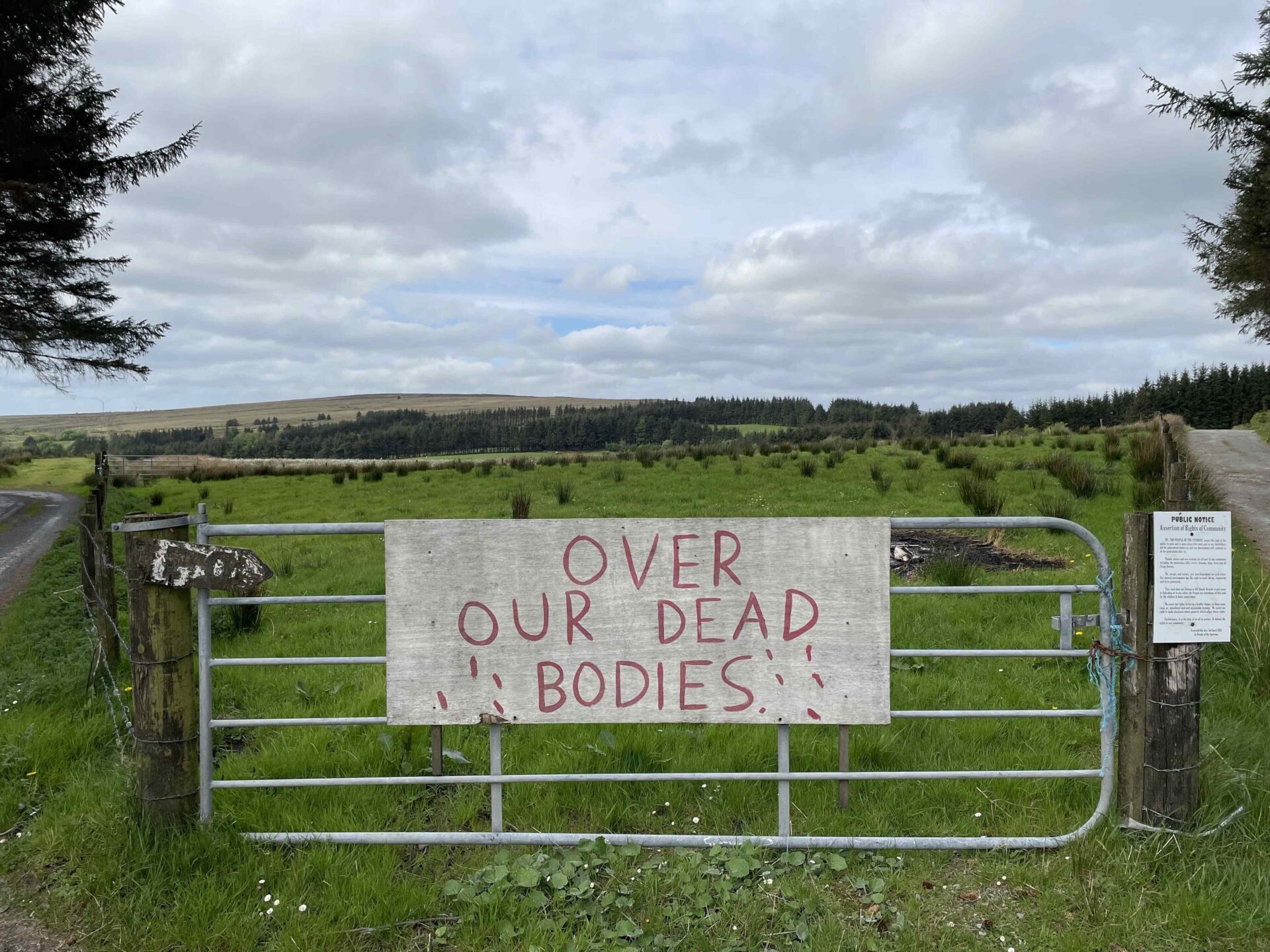“Are you for the mine? If you’re for the mine you’re not welcome here.” The farmer speaks from the cab of his tractor. He’s a lean man with a closed face, and he doesn’t like the look of me. We’re on a lane in the Sperrin Mountains, a 20-minute drive from Omagh. Just to the north, up the track and over the ridge, is a parcel of land known as Curraghinalt. A US-Canadian company called Dalradian wants to build a gold mine there.
This is rough upland, yolky with whin and nearly silent. I hear breeze and birdsong, sheep exchanging peevish mehs, and the tick of the tractor’s cooling engine. Once I’ve assured the farmer that I have no connection to the mining industry, he opens up a little, talks about his fears. “All that toxic waste,” he says. “We want to keep it like it is: green fields. We’re thinking about the next generation.”

It’s a perfect soundbite, delivered with something approaching weariness. This is understandable. The affair has dragged on for years and years. Dalradian began exploratory work at Curraghinalt in 2009, and submitted their first planning application for a mine in 2017. When this was rejected by Northern Ireland’s Department for Infrastructure, the firm submitted revised applications in 2019 and 2020. A long-awaited inquiry into the proposed mine by the Planning Appeals Commission was suspended last year, and put on hold again in January 2025. A final decision on the project, promised for early May, has yet to materialise.
Dalradian has already completed 190,000 meters of exploratory drilling. Significant deposits of gold, silver and copper have been identified, alongside minerals like cobalt and tellurium. The company estimates that the mine would produce 3.5 million ounces of gold, 1.7 million ounces of silver, and 15,000 tonnes of copper over its two-decade lifespan. In addition, Dalradian promises the creation of 1,000 jobs, and a £1 billion boost to the regional economy, together with £4 million worth of investment in local community groups. When the mining is complete, a comprehensive decommissioning process would return the site to something like its former glory. An exquisitely curated website envisions a “state-of-the-art modern underground mine”.
Some welcome the prospect of employment and investment in a region where good jobs are hard to come by. A group called The Silent Majority says it’s “positive about the idea of a good well-paid, well-regulated industry like mining coming to our locality”. Yet this view doesn’t seem to be widely shared by people on the ground, whether it’s local farmers or the residents of the nearby village of Greencastle. There’s a seam of tension beneath the green fields, the kind of tension that leads a farmer to quiz a walker on a tranquil lane. As he starts his tractor and pulls away, he calls out to me: “You’ll likely be stopped again.”
A short stroll brings me to a barbed wire fence. This is as close as you can get to Curraghinalt’s southern boundary. There’s a sign on the fence, cleanly stencilled in arterial red. A skull and crossbones, universal symbol for poison, and a simple message: “DALRADIAN OUT OF IRELAND”. Then I turn around and see the valley beneath me. The little fields lock together, up and down they go, all the way to far mountains, purple as bruises on the horizon. This isn’t gentle countryside. It’s a shaggy, pubescent place. There’s brown sedge and the croziers of new bracken pushing up, cotton grass and heather and stunted trees just blurring into leaf.

This is what the farmer wants to protect. Dalradian states that their work would be ecologically sound, and has repeatedly and vigorously denied that the mine would produce toxic waste. Early plans to use cyanide at the mining site were withdrawn by the company after the failure of their first planning application, and they maintain that there is no danger of water pollution. Not everyone is convinced.
Just last week, An Taisce, the National Trust for Ireland, published a report highlighting several areas of concern. They submit that the risk of a “toxic slurry” formed of sulphuric acid, mercury and arsenic leaching from mined rock has not been fully addressed. Furthermore, An Taisce argue that wastewater from the mine, due to be discharged into the Owenreagh and Owenkillew rivers, will contain heavy metals like cadmium and lead.
Even if these concerns were baseless, it seems obvious that a mine would irrevocably change the character of the region. The Sperrins are an Area of Outstanding Natural Beauty. While this doesn’t protect the region from large-scale development altogether, it does mean that the local authority has a duty to “preserve and enhance the beauty of the area”. Of course, this is a working landscape already; tractors and vans are part and parcel of rural life. But the thought of huge lorries coming and going from Curraghinalt on these narrow roads is a grim one. It’s difficult to imagine a similar proposal getting this far in the Cotswolds.
“It’s difficult to imagine a similar proposal getting this far in the Cotswolds.”
“Are you a stranger?” The woman pops around a bend in the track and starts talking. She offers to squire me around for a bit, as long as I don’t name her. “A local woman,” I say, and she laughs. “Yes, that’ll do well.” We dander along the path that traces Curraghinalt’s southern boundary and chat about the mine. “Oh, it’s been total division,” she tells me. “Nearly caused war.” Division between locals, one of whom is said to have sold some land to Dalradian, and division between the community and the big corporation. Both sides have accused each other of intimidatory behaviour in the past. I tell the woman about the farmer’s suspicion of me, and she nods. Dalradian has seeded mistrust among otherwise warm and generous people here. Even before it’s been approved, the proposed mine has become “an unhealthy intrusion into people’s lives”.
My guide is horrified by the potential for pollution and the destruction of the region’s way of life. But what really gets her going is the money. “Some people are always looking for the next big money spin. You know: ‘I’m all in — who can get the biggest chip? It doesn’t matter who I trample over, or the land or the culture, let’s take it all.’ And then deciding, ‘I’ve not got enough, so I’ll go back for some more.’ It’s just infinite greed.”
We’re admiring some sheep when a car pulls up. A man jumps out and the questions start again. Who am I? What am I doing? He points at my notebook: “What are you writing?” Again, there’s tension and suspicion. Who do I write for? I consider answering “Mining Illustrated” but decide this isn’t the time for levity. Again, I explain that I’m here to research an article about the project, nothing more. Again, the tension passes. His face loosens into a smile, and he becomes affable and welcoming. He’s happy to talk, but he too opts for anonymity: “Keep my name out of it.”
“You can see what we stand to lose here,” he says. He sweeps his arm over the fields, full of pride. “[Dalradian] are going to destroy everything. It’s common sense.” I ask about his hopes for the planning inquiry and he shrugs, clearly not expecting much. But he’s quietly confident that the local community will win the day. “We’ll fight it out,” he grins. “Too many people spent too long keeping [this land] to lose it over this.” As he drives off, the woman turns to me and says, “If that man thought you were with Dalradian, he’d have chased you.”
I walk out to the edge of a small field, the site of many protests over the years. The focal point is a group of caravans draped in banners. The largest reads: “We are not afraid. This is our land. This is our home. We will die for it.” Someone has painted “GPO” onto the rocks here. The acronym stands for Greencastle People’s Office, but inevitably calls Dublin’s General Post Office to mind, the Easter Rising given new meaning on a hillside in County Tyrone. On a gate further down the track, a big sign offers an even clearer message: “OVER OUR DEAD BODIES”. Dabs of red paint around the words recall drops of blood.
Criticism of the proposed mine has focused on its potential impact on land and water. Less has been said about the impact it has already had on the people themselves. Many locals have endured years of strain and uncertainty, and can only continue to protest as the planning inquiry staggers around like a drunk looking for a dropped key. Still, if exhaustion was going to set in it would have done so by now. When we say goodbye, the local woman shakes my hand and says, “If they go ahead with the mine, I’ll be leaving.” But I don’t believe her.

















